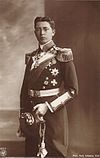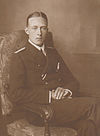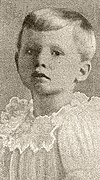
Quick Facts

Biography
Prince Albert William Henry of Prussia (German: Prinz Albert Wilhelm Heinrich von Preußen; 14 August 1862 – 20 April 1929) was a younger brother of German Emperor William II and a Prince of Prussia. He was also a grandson of Queen Victoria. A career naval officer, he held various commands in the Imperial German Navy, eventually rose to the rank of Grand Admiral and Generalinspekteur der Marine.
Biography
Born in Berlin, Prince Henry was the third child and second son of eight children born to Crown Prince Frederick (later Emperor Frederick III), and Victoria, Princess Royal of the United Kingdom (later Empress Victoria and in widowhood Empress Frederick), eldest daughter of the British Queen Victoria. Henry was three years younger than his brother, the future Emperor William II (born 27 January 1859). He was born on the same day as King Frederick William I "Soldier-King" of Prussia.
After attending the gymnasium in Kassel, which he left in the middle grades in 1877, the 15-year-old Henry entered the Imperial Navy cadet program. His naval education included a two-year voyage around the world (1878 to 1880), the naval officer examination (Seeoffizierhauptprüfung) in October 1880, and attending the German naval academy (1884 to 1886).

Early commands
As an imperial prince, Henry quickly achieved command. In 1887, he commanded a torpedo boat and simultaneously the First Torpedo Boat Division; in 1888 the Imperial yacht SMY Hohenzollern; from 1889 to 1890 the second-class cruiser SMS Irene, the armored coastal defense ship SMS Beowulf, and the capital ships SMS Sachsen and SMS Wörth.
Squadron commands
From 1897, Prince Henry commanded several naval task forces; these included an improvised squadron that took part with the East Asia Squadron in consolidating and securing the German hold on the region of Kiaochow and the port of Tsingtao in 1898. The prince’s success was more of the diplomatic than the military variety; he became the first European potentate ever to be received at the Chinese imperial court. In 1899 he became officially the commander of the East Asia Squadron, later of a capital-ship squadron and in 1903 commander of the Baltic Sea naval station. From 1906 to 1909, Henry was commander of the High Seas Fleet. In 1909, he was promoted to Grand Admiral.
World War I


At the beginning of World War I, Prince Henry was named Commander-in-Chief of the Baltic Fleet. Although the means provided him were far inferior to Russia’s Baltic Fleet, he succeeded, until the 1917 Revolution, in putting Russia’s naval forces far on the defensive, and hindered them from making attacks on the German coast. After the end of hostilities with Russia, his mission was ended, and Prince Henry simply left active duty. With the war’s end and the dissolution of the monarchy in Germany, Prince Henry left the Navy.
Family
On 24 May 1888, Henry married Princess Irene of Hesse and by Rhine, his first cousin. The marriage produced three children:
| Name | Picture | Birth | Death | Notes |
|---|---|---|---|---|
| Waldemar William Louis Frederick Victor Henry |  | 20 March 1889 | 2 May 1945 | Married Princess Calixta of Lippe-Biesterfeld, but had no issue. |
| William Victor Charles Augustus Henry Sigismund |  | 27 November 1896 | 14 November 1978 | Married Princess Charlotte of Saxe-Altenburg, had issue. |
| Henry Victor Louis Frederick |  | 9 January 1900 | 26 February 1904 | Was a haemophiliac and died aged four after bumping his head |

Their sons Waldemar and Heinrich were both hemophiliacs, a disease which they inherited through Irene from the maternal grandmother of both of their parents, Queen Victoria, who was a carrier.
Personality and private life

Henry had little in common with his brother, the German Emperor. He lacked, for example, William II's erratic nature and egotism. Contrary to popular belief, the kaiser and the prince were both truly popular inGermany, and on account of his humble and open manner, Henry was beloved by those under his command. On foreign travels, he was a good diplomat, who, unlike his brother, was able to strike the right tone. Thus, on his 1902 trip to the United States, Henry made a favorable impression with the critical American press and succeeded in winning the sympathy of more than just the numerous German-American segment of the population.
As a naval officer, Henry had a profession that completely satisfied him and that he loved. He was thoroughly a pragmatist. He received one of the first pilot’s licenses in Germany, and was judged a spirited and excellent seaman. He was dedicated to modern technology and was able to understand quickly the practical value of technical innovations. A yachting enthusiast, Prince Henry became one of the first members of the Yacht Club of Kiel, established by a group of naval officers in 1887, and quickly became the club's patron.
Henry was interested in motor cars as well and supposedly invented a windshield wiper and, according to other sources, the car horn. In his honor, the Prinz-Heinrich-Fahrt (Prince Heinrich Tour) was established in 1908, like the earlier Kaiserpreis a precursor to the German Grand Prix. Henry and his brother William gave patronage to the Kaiserlicher Automobilclub (Imperial Automobile Club).
Henry also was an early proponent of introducing submarines and airplanes. He had merchant ships converted into seaplane tenders for operations in the Baltic Sea.
Henry respected his brother, but this attitude was not returned in the same measure. William kept his younger brother far from politics, although Henry served as his representative as long as the Crown Prince was still in his minority. Henry complied with this, for he did not interest himself in either politics or grand strategy. He did not recognize what political effect the German naval build-up would entail, and also would not have been in the position to move his brother toward a different policy.
After the German Revolution, Henry lived with his family in Hemmelmark near Eckernförde, in Schleswig-Holstein. He continued with motor sports and sailing and even in old age was a very successful participant in regattas. He popularized the Prinz-Heinrich-Mütze ("Prince Henry cap"), which is still worn, especially by older sailors.
In 1899, Henry received an honorary doctorate (Doctor of Engineering honoris causa) from the Technical University of Berlin. Also in foreign countries he received numerous similar honors, including an honorary doctorate (LL.D.) from Harvard University in March 1902, during his visit to the United States.
Prince Henry died of throat cancer, as his father had, in Hemmelmark on 20 April 1929.
George Burroughs Torrey painted a portrait of him.
Naval career and advancement
- Unterleutnant zur See, 14 August 1872; Basic Training and Naval Academy 1877-1878
- Leutnant zur See, 18 October 1881; Training Cruises and Naval Academy 1878-1882
- Kapitänleutnant, 18 October 1884; Executive Officer, Armored Cruiser SMS Oldenburg, 1886
- Korvettenkapitän, 18 October 1887; Commander, 1st Torpedo Boat Division, 1887; Commander, Imperial Yacht SMY Hohenzollern, 1888
- Kapitän zur See, 27 Januar 1889; ; Commander, Cruiser SMS Irene, 1889–1890; Commander, Armored Coastal Defense Ship SMS Beowulf, 1892; Commander, Armored Cruiser SMS Sachsen, 1892–1894; Commander, Armored Ship of the Line SMS Wörth, 1894–1895
- Konteradmiral, 15 September 1895; Commander, 2nd Division, 1st Battle Squadron, 1896–1897; Commander, 2nd Division, Cruiser Squadron, 1897–1899
- Vizeadmiral, 5 December 1899; Commander, Cruiser Squadron, 1899–1900; Commander, 1st Battle Squadron, 1900–1903
- Admiral, 13 September 1901; Commanding Admiral, Baltic Sea Naval Command, 1903–1906, Commander, High Seas Fleet, 1906–1909
- Großadmiral, 4 September 1909; Inspector General of the Imperial Navy, 1909–1918; Commander-in-Chief, Baltic Fleet, 1914–1918
Regimental commissions and honorary ranks
German
- 1. Garde-Regiment zu Fuß (Royal Prussian 1st Regiment of Foot Guards) – Leutnant (Second Lieutenant) through Generaloberst im Range eines Generalfeldmarschalls (Colonel-General in the Rank of Field Marshal), 1871 - 1918
- Kgl. Sächs. 2. Grenadier-Regiment Kaiser Wilhelm, König von Preußen Nr. 101 (Royal Saxon 2nd Grenadier Regiment)
- Kgl. Bayerisches Artillerie-Regiment Nr. 8 (Royal Bavarian 8th Artillery Regiment) – Generaloberst im Range eines Generalfeldmarschalls and Chef (Colonel in Chief)
- 1. Großherzogl. Hessisches Feldartilleree-Regiment 25 (Grand Duchy of Hesse 2nd Artillery Regiment)
- Fußilier-Regiment “Prinz Heinrich von Preußen” (Brandenburgisches) Nr 35 (The Brandenburg Fusilier Regiment) - Generaloberst im Range eines Generalfeldmarschalls and Chef (Colonel in Chief)
Foreign
 Austria-Hungary: K.u.K. Infantry Regiment Nr. 20 – Oberstinhaber (Colonel in Chief)
Austria-Hungary: K.u.K. Infantry Regiment Nr. 20 – Oberstinhaber (Colonel in Chief) Austria-Hungary: K.u.K. Kriegsmarine (Navy) – Vizeadmiral (vice admiral)
Austria-Hungary: K.u.K. Kriegsmarine (Navy) – Vizeadmiral (vice admiral)- Austria-Hungary: K.u.K. Kriegsmarine - Konteradmiral (rear-admiral) 1899
 United Kingdom: Royal Navy – Admiral (Honorary) 13 September 1901
United Kingdom: Royal Navy – Admiral (Honorary) 13 September 1901- Royal Navy - Vice-Admiral (Honorary) 5 February 1901.
 Russian Empire: Imperial Dragoon Regiment Nr. 33 – Colonel
Russian Empire: Imperial Dragoon Regiment Nr. 33 – Colonel
Titles, styles, and honours
Titles and styles
- 14 Aug 1862 – 20 April 1929: His Royal Highness Prince Henry of Prussia
Honours
- National
 Prussia:
Prussia:- Order of the Black Eagle, Knight with Collar, 1872
- Order of the Red Eagle, Grand Cross, 1872 (by statute of the Order of the Black Eagle, for princes of Prussia)
- Order of the Prussian Crown, Knight 1st Class, 1872 (by statute of the Order of the Black Eagle, for princes of Prussia)
- Royal House Order of Hohenzollern, Grand Commander with Collar chain
- Johanniter Order, Commander of Justice
- Long Service Award
 Hohenzollern-Sigmaringen: Princely House Order of Hohenzollern, Cross of Honour 1st Class
Hohenzollern-Sigmaringen: Princely House Order of Hohenzollern, Cross of Honour 1st Class
 Anhalt: Order of Albert the Bear, Grand Cross
Anhalt: Order of Albert the Bear, Grand Cross Baden:
Baden:- House Order of Fidelity, Knight
- Order of Berthold the First, Grand Cross
- Order of the Zähringer Lion, Grand Cross
 Bavaria: Order of St. Hubert, Knight
Bavaria: Order of St. Hubert, Knight Bremen,
Bremen,  Lübeck,
Lübeck,  Hamburg: Hanseatic Crosses
Hamburg: Hanseatic Crosses Brunswick: Order of Henry the Lion, Grand Cross
Brunswick: Order of Henry the Lion, Grand Cross

 Ernestine duchies: Saxe-Ernestine House Order, Grand Cross
Ernestine duchies: Saxe-Ernestine House Order, Grand Cross Hesse and by Rhine:
Hesse and by Rhine:- Ludwig Order, Grand Cross
- House Order of the Golden Lion, Knight
- Medal of Bravery
 Mecklenburg: House Order of the Wendish Crown, Grand Cross with Crown and Diamonds
Mecklenburg: House Order of the Wendish Crown, Grand Cross with Crown and Diamonds Oldenburg: House Merit Order of Duke Peter Friedrich Ludwig, Grand Cross with Golden Crown
Oldenburg: House Merit Order of Duke Peter Friedrich Ludwig, Grand Cross with Golden Crown Saxe-Weimar-Eisenach: Order of the White Falcon, Grand Cross
Saxe-Weimar-Eisenach: Order of the White Falcon, Grand Cross Saxony:
Saxony:- Order of the Rue Crown, Knight
- Albert Order, Grand Cross with Crown and Swords
 Württemberg: Order of the Württemberg Crown, Grand Cross
Württemberg: Order of the Württemberg Crown, Grand Cross
- Foreign
 Austria-Hungary: Order of St. Stephen of Hungary, Grand Cross, 1872
Austria-Hungary: Order of St. Stephen of Hungary, Grand Cross, 1872 Belgium: Royal Order of Leopold, Grand Cordon
Belgium: Royal Order of Leopold, Grand Cordon Empire of Brazil: Imperial Order of the Southern Cross, Grand Cross
Empire of Brazil: Imperial Order of the Southern Cross, Grand Cross Kingdom of Bulgaria: Order of St. Alexander, Grand Cross
Kingdom of Bulgaria: Order of St. Alexander, Grand Cross Denmark: Order of the Elephant, Knight, 30 July 1888
Denmark: Order of the Elephant, Knight, 30 July 1888 Kingdom of Greece: Order of the Redeemer, Grand Cross
Kingdom of Greece: Order of the Redeemer, Grand Cross Kingdom of Hawaii: Royal Order of Kalākaua I, Grand Cross, 1881
Kingdom of Hawaii: Royal Order of Kalākaua I, Grand Cross, 1881 Kingdom of Italy:
Kingdom of Italy:- Order of the Annunciation, Knight
- Order of Saints Maurice and Lazarus, Grand Cross
 Holy See: Supreme Order of Christ, Knight
Holy See: Supreme Order of Christ, Knight Tuscan Grand Ducal family: Order of St. Joseph, Grand Cross
Tuscan Grand Ducal family: Order of St. Joseph, Grand Cross
 Empire of Japan: Order of the Chrysanthemum, Grand Cordon
Empire of Japan: Order of the Chrysanthemum, Grand Cordon Korean Empire: Grand Order of the Golden Ruler, Grand Cordon
Korean Empire: Grand Order of the Golden Ruler, Grand Cordon Principality of Montenegro: Order of Danilo I, Grand Cross
Principality of Montenegro: Order of Danilo I, Grand Cross Netherlands: Order of the Netherlands Lion, Grand Cross
Netherlands: Order of the Netherlands Lion, Grand Cross Ottoman Empire: Order of Osmanieh, 1st Class with Diamonds
Ottoman Empire: Order of Osmanieh, 1st Class with Diamonds Kingdom of Portugal:
Kingdom of Portugal:- Sash of the Two Orders
- Order of the Tower and Sword, Grand Cross
 Qing dynasty: Order of the Double Dragon, Class I Grade I
Qing dynasty: Order of the Double Dragon, Class I Grade I Kingdom of Romania: Order of the Star of Romania, Grand Cross
Kingdom of Romania: Order of the Star of Romania, Grand Cross Russian Empire:
Russian Empire:- Order of St. Andrew the Apostle the First Called, Knight
- Order of St. Alexander Nevsky, Knight
- Order of St. Anna, 1st Class
- Order of St. Stanislaus, 1st Class
- Imperial Order of the White Eagle, Knight
 Kingdom of Serbia: Royal Order of the White Eagle, Grand Cross
Kingdom of Serbia: Royal Order of the White Eagle, Grand Cross Siam: Order of the Royal House of Chakri, Knight
Siam: Order of the Royal House of Chakri, Knight Spain:
Spain:- Order of the Golden Fleece, Knight, 1883
- Order of Naval Merit, 4th Class

 Sweden-Norway:
Sweden-Norway:- Royal Order of the Seraphim, Knight, 17 October 1887
- Royal Norwegian Order of St. Olav, Grand Cross
 United Kingdom:
United Kingdom:- Order of the Bath, Honorary Grand Cross, 13 August 1881 (expelled in 1915)
- Order of the Garter, Knight, 8 August 1889 (expelled in 1915)
- Royal Victorian Chain, 9 August 1902 (expelled in 1915)
 Venezuela: Order of the Liberator, Collar
Venezuela: Order of the Liberator, Collar
Honorary degrees and offices
- Freedom of the City of New York, 25 February 1902, during his visit to the city.
- Freedom of the City of Philadelphia, 10 March 1902, during his visit to the city.
- Honorary doctorate (LL.D.) from Harvard University, 6 March 1902.
 Leo
Leo